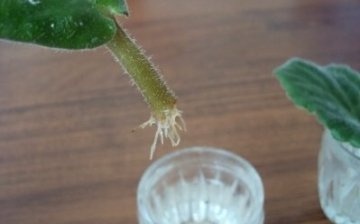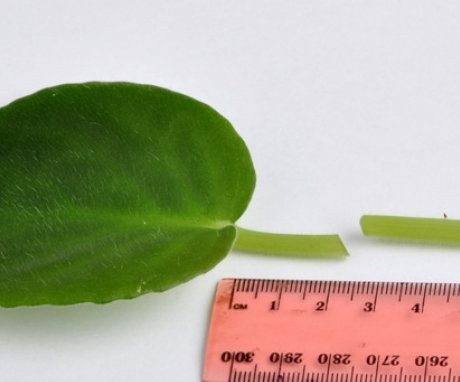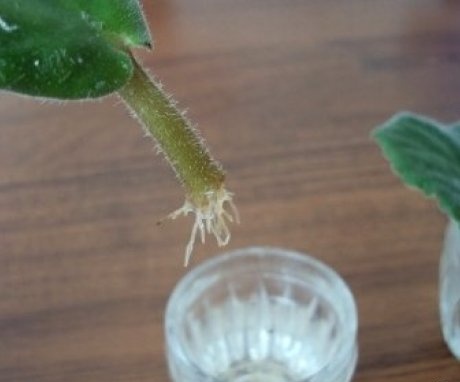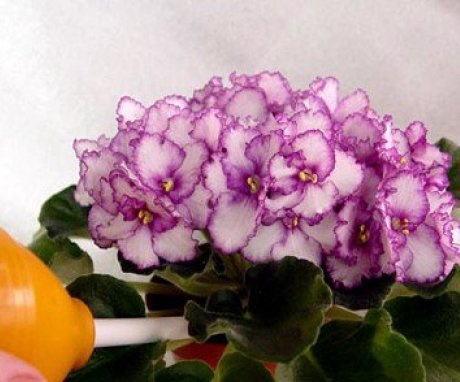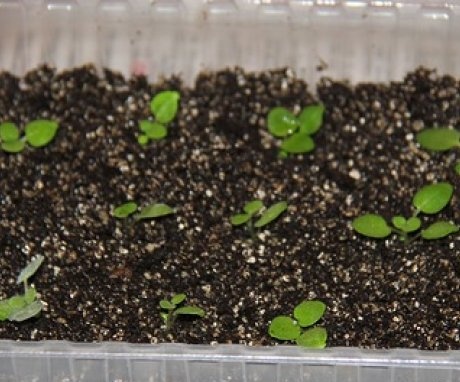How to propagate a violet? The main breeding methods for Saintpaulia
The indoor violet, aka Saintpaulia, has long become one of the favorite window sill decorations. Delicate small plant with fragile-looking leaves and charming flowers is eye-catching and uplifting. In many cultures, it was the violet that was considered a symbol of love and tenderness. It is worth purchasing one such plant, and very soon you will want to propagate it so that violets bloom in all rooms. This is not difficult to do, and yet you need to know some of the nuances. How to propagate a violet?
Content
- Violet breeding methods
- Choosing a leaf for obtaining shoots
- Preparing a cut leaf for planting
- Home violet care
- Reproduction of violets by seeds
Violet breeding methods
Despite the fragile appearance, these are quite unpretentious plants, therefore transplant a bush and propagate even a novice florist can do it.
Some hobbyists exchange violet leaves to get stalks and collect whole collections of plants with colorful buds at home.
There are several ways to propagate a violet:
- Reproduction in a separate sheet. This is the simplest and most common method.
- Reproduction by stepchildren. This method is used less often, but for some species of violets, it is the only breeding opportunity. For example, chimera violets cannot be propagated by a leaf, since in this case they will lose their unique color of flowers.
- Reproduction by peduncles. This is the rarest method used for varieties of special colors: a correctly cut flower stalk also produces young shoots.
- Reproduction by seeds. It is used for selective breeding of new varieties and requires special knowledge. When crossing plants with different colors of buds, breeders get the most unusual color combinations and types of coloring.
- The most affordable way to propagate a violet is by propagation from a single leaf. Only when you master this method, you can move on to more complex experimental transplants. With this method, you can get a plant with the same petal color, it will quickly take root and will delight you with the first flowering. In the future, it can also be used for reproduction.
The best way to reproduce violets is start in spring and summer, since during these months there is an active growth of young shoots. To get children, you need to choose a healthy plant, the leaves should not be damaged or traces of pests.
The success of the transplant depends on the correct choice of plant.
Choosing a leaf for obtaining shoots
In order for the violet to sprout quickly, it is necessary to choose the right leaf for transplanting.
To do this, you need to take a pot and examine the plant: you will see that the leaves grow in rows.
The choice depends on the location:
- It is not recommended to cut the leaves from the middle of the outlet, as in this case there is a risk of damaging the growing point and the plant will be seriously damaged.
- In addition, young leaves are usually small, so they may not have enough strength for new processes.
- The lowest leaves are also not suitable for planting, as they are too old, and the appearance of new shoots will have to wait for a very long time.
- Optimal solution - large healthy leaf from the second or third row.
- Pay attention to its color: it should be bright green, the color is more saturated around the edges.
- The surface of the sheet should be free of stains, cuts and traces of other damage.
- In addition, the young leaf should be firm and elastic to the touch.
If you take a leaf for transplanting not at home, but at an exhibition or from friends, it is recommended to wrap it in a wet cloth immediately after cutting the petiole so that the leaf does not wilt before you bring it home.
In any case, you should not break off the leaf, since in this case you will damage both the petiole and the plant itself.
It is better carefully cut off the petiole, leaving 3-4 cm. length. The leaf is cut at an angle of 45 degrees, on the parent plant, the cut is sprinkled with crushed activated carbon. In order for the plant to heal the frame faster, it is recommended to moisten the knife in a disinfectant solution.
If a long time has passed since the moment of cutting, to revive the leaf, it is lowered into a container with a weak solution of potassium permanganate for 2 hours, and then dried. If the cut has already dried, then it must be renewed before putting it in the water.
Now the main task is to get young roots so that the plant can live on its own.
Preparing a cut leaf for planting
You can root a violet leaf in water or directly in the ground, but the first method is more effective.
Root the plant not difficult, but it can take quite a long time.
Sequencing:
- Take a glass with a volume of 0.2 liters and pour boiled water at room temperature into it.
- It is recommended to put an activated carbon tablet in the water.
- Place the violet leaf in the water and move the glass to the windowsill.
- Violets cannot be placed in the open sun.
- In addition, this plant does not like drafts, so you should not place it directly under the window.
- Water is added as it evaporates, you need to periodically check whether the plant has roots.
- The leaf may begin to rot at the base, in which case it is slightly trimmed, after which the process starts over.
- When the roots grow by about a centimeter or more, you can transplant the violet into the ground.
- It is not particularly demanding on the soil, so you can purchase a standard soil mixture at any specialized store. Sometimes superphosphate, sphagnum moss and charcoal are added to it.
There is another way - preparing the sheet directly in the ground.
In this case, there is less risk that the root will rot, but you will not be able to observe the process, and it will be difficult to understand if the small violet is already rooted.
- In this case, you need take a glass silt and a small plastic pot, holes are made in the bottom for water drainage.
- At the bottom, foam or other drainage material is poured, which will prevent the roots from starting to rot due to excess moisture.
- A violet leaf is planted with a petiole in moistened soil, the pot is well watered.
- After that, you can make a mini greenhouse, especially if the room is cold or humid.
- The pot is covered with a plastic bag, periodically the greenhouse can be aired for several minutes a day.
In these conditions, it will be easier for the violet to give new shoots. When the children get stronger, and a new leaf rosette begins to form, the violet can be transplanted into a more spacious pot. They tolerate both natural and artificial lighting well, but do not like the cold, so it is better not to put the violet on a cold windowsill if it blows through the cracks in the frame.
Home violet care
Saintpaulia - far from the most capricious plants, and yet you also need to be able to take care of them.
A novice florist must remember a few rules that will provide green pets with fast growth and excellent flowering:
- Violets love a constant temperature, they do not need winter cooling.
- Ideal conditions are + 20-25 degrees. In this case, they will constantly bloom, and the flower stalks will be strong with a large number of buds.
- These beauties tolerate heat worse than cold, so they should not be allowed to bloom in intense heat.
- Violets do not like direct sunlight, so a north or east window is most suitable for them.
- Different varieties need a different type of light: if the leaves are large, dark green, they need a lot of light, if they are small and pale, the light requirements are lower.
- In order for the rosette of leaves to grow evenly, you must periodically turn the pot.
- If there is little light, the petioles will begin to painfully stretch upwards; if there is too much light, the leaves will become pale, and sunburns in the form of brown spots may appear on them.
- Violets are watered sparingly, as the roots may begin to rot.
- For irrigation, only settled water is needed, while it must be warm.
- Care should be taken when watering, as water should not fall on the leaves and in the middle of the outlet.
- The hairs on the leaf surface prevent water droplets from rolling, and the sun's rays turn the droplets into real incendiary lenses. As a result, burns will appear on the leaves.
- Water the plants when the earthen lump dries up.
- Dust is periodically removed from the leaves: for this they need to be washed with warm water, and the plant is allowed to dry in a warm and dark place.
For artificial lighting, it is best to choose fluorescent lamps, since the lighting from them is soft and diffused. If there is an opportunity for a separate room, you can purchase special lamps designed specifically for flower gardens and greenhouses.
Reproduction of violets by seeds
The most difficult breeding option is selective cultivation using seeds.
In this case, you need:
- Select two parent plants and cross-pollinate.
- Collect the pollen from the buds and transfer it to the pistils of another plant.
- After a while, the process of ripening of the seed pods will begin.
- When they are ready, they should dry well.
- Finished seeds are kept in a dry place for some time.
- Then they need to be sprayed with water and placed in a container with soil.
- Seeds and first shoots need to be provided with greenhouse conditions with regular ventilation.
- In the future, the sprouts can be transplanted into separate pots, like any seedlings, and soon you may have your own variety of violets.
Indoor violet - a gentle, very beautiful home plant. She will become wonderful decoration for your homeand they are worth all the care and transplantation.
More information can be found in the video.






